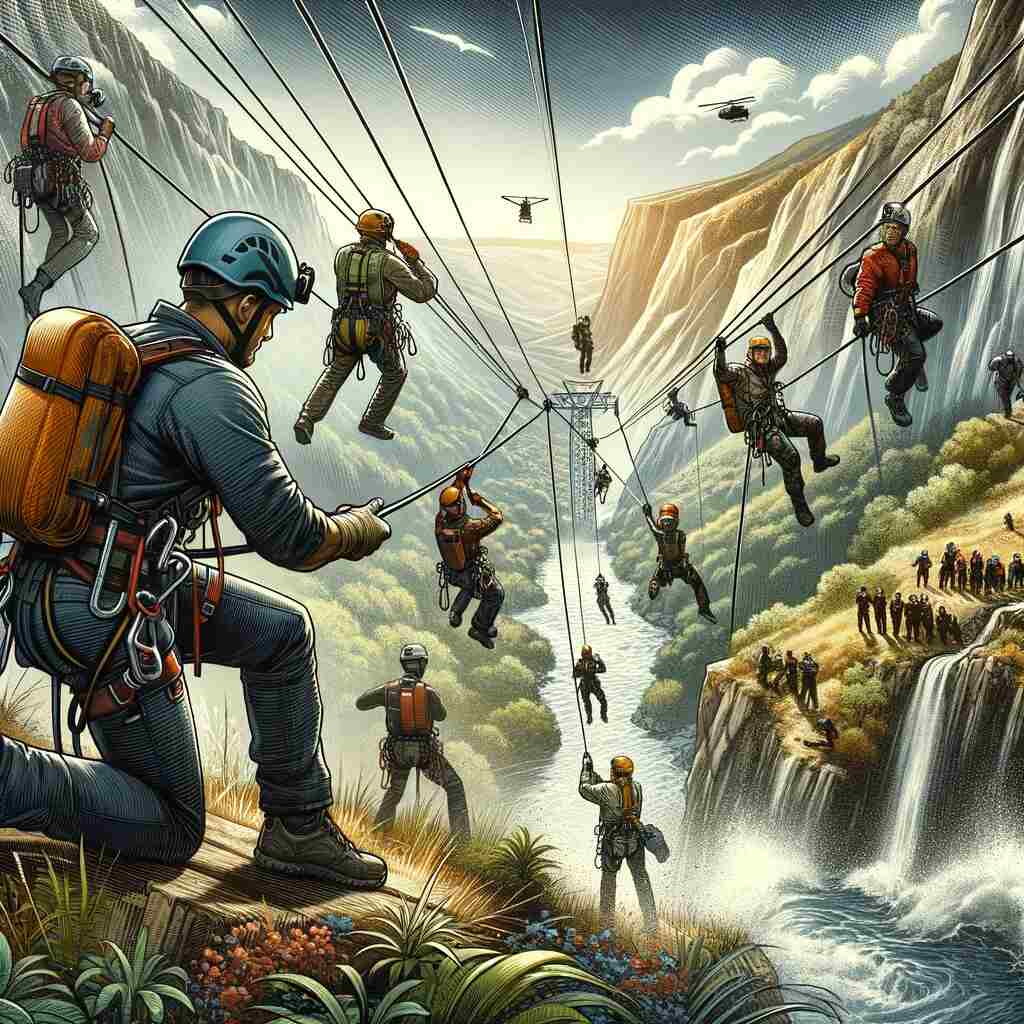Rescue operations are a critical component of emergency response efforts worldwide, designed to save lives and provide assistance in times of crisis. While traditional rescue methods involving helicopters, boats, and ground personnel are often employed, innovative technologies and techniques have emerged to enhance the efficiency and effectiveness of these missions. One such innovation is the use of zip lines in rescue operations.
Ziplines, originally designed for recreational purposes and adventure sports, have found a unique and invaluable application in the realm of emergency response. This article explores the fascinating world of ziplines and how they are employed in various rescue operations, ranging from swiftwater rescues to mountainous terrain extrications. We will delve into the mechanics, equipment, training, and real-life examples that showcase the versatility and significance of ziplines in saving lives.
Understanding Ziplines
Before we delve into their use in rescue operations, it’s important to understand what ziplines are and how they work.
-
What is a Zipline?
A zipline, also known as a zip line or zip wire, is a cable-based transportation system that typically consists of a cable stretched between two points, with a pulley or trolley attached to it. Riders, or in this case, rescuers and victims, use the pulley to traverse the distance from one point to another. Ziplines are often installed at an incline, allowing gravity to propel the rider along the cable.
-
Mechanics of a Zipline
The mechanics of a zipline are quite straightforward:
- Gravity: Gravity plays a significant role in zipline operation. When a person (or an object) is attached to the pulley and begins the descent, gravity provides the necessary force to move them along the cable.
- Tension: Proper tension in the cable is essential for a safe ziplining experience. Too much tension can lead to excessive speed, while too little tension may cause the cable to sag, making it difficult to traverse.
- Braking System: Most ziplines have a braking system to control the speed and safely stop the rider at the end of the line. This is a crucial safety feature in rescue operations.
- Harness and Safety Gear: Riders wear harnesses and other safety gear to secure themselves to the pulley and prevent falls.
- Cable Material: Zipline cables are typically made of steel or other strong materials capable of withstanding the weight of a person or equipment.
Ziplines in Swiftwater Rescues
Swiftwater rescue operations involve saving individuals trapped in fast-moving water, such as rivers, creeks, or floodwaters. These situations can be incredibly challenging due to the unpredictable nature of water currents. Ziplines have proven to be invaluable tools in swiftwater rescue operations.
-
River Crossings
In many swiftwater rescue scenarios, traditional methods like boats or helicopters may not be suitable due to the rapid flow of water. In such cases, rescuers can set up a zipline across the river, allowing them to transport personnel and equipment safely. Victims can be harnessed and securely transported across the river using the zipline, avoiding the dangers of drowning or hypothermia.
-
Reach-In Rescues
In situations where victims are stranded on small islands or debris in the water, rescuers can use ziplines to reach and extract them. By setting up a zipline from the shore to the victim’s location, rescuers can quickly establish a lifeline for both the victim and themselves, minimizing the time spent in the treacherous water.
-
Training and Equipment
Swiftwater rescue teams receive specialized training in zipline operations for swiftwater scenarios. They use specialized equipment, such as high-strength cables, pulleys, and harnesses designed to withstand the harsh conditions of fast-moving water. Proper training ensures that rescuers can execute zipline rescues safely and effectively.
Ziplines in Mountain and Wilderness Rescues
Mountainous terrain and remote wilderness areas present unique challenges to rescue operations. Ziplines offer a valuable solution for reaching inaccessible or treacherous locations.
-
Cliff Extrications
When individuals become stranded on cliffs or steep slopes, traditional methods of rescue may be difficult or impractical. Ziplines can be used to create a highline system, allowing rescuers to access the stranded person safely. This technique is especially valuable when helicopters cannot be deployed due to rugged terrain or adverse weather conditions.
-
Remote Wilderness Evacuations
In remote wilderness areas, ziplines can provide a means of evacuating injured hikers, climbers, or campers from difficult-to-reach locations. Rescuers can set up ziplines between trees or rock formations to facilitate the safe extraction of individuals who are injured or unable to hike out on their own.
-
Equipment and Safety Measures
Rescue teams operating in mountain and wilderness environments are equipped with specialized gear for zipline operations. This includes lightweight and portable zipline kits that can be carried to remote locations. Additionally, safety protocols are essential to ensure the secure setup and operation of ziplines in challenging terrain.
Urban Search and Rescue (USAR)
Urban search and rescue operations are conducted in densely populated areas, often in response to natural disasters such as earthquakes, building collapses, or large-scale emergencies. Ziplines can be an asset in these scenarios.
-
Building Access
In the event of a collapsed building or a structure that is unsafe for rescuers to enter, ziplines can be used to establish a secure means of access. Rescuers can set up ziplines from neighboring buildings or elevated positions to reach trapped individuals, provide medical care, and evacuate them to safety.
-
Debris Removal
In USAR operations, debris removal is a critical task. Ziplines can be used to transport equipment and materials, such as cutting tools or medical supplies, to areas that are otherwise inaccessible. This can expedite the process of clearing debris and locating survivors.
-
Coordination and Communication
Ziplines can also be employed for communication purposes in urban search and rescue operations. Rescuers can use ziplines to establish lines for the passage of messages, equipment, or even small teams between different sections of a disaster site, improving coordination efforts.
Real-Life Examples
Several real-life examples illustrate the successful use of ziplines in rescue operations:
-
Nepal Earthquake (2015)
In the aftermath of the devastating earthquake that struck Nepal in 2015, ziplines played a crucial role in delivering aid and assistance to remote and inaccessible villages in the Himalayan region. Rescuers used ziplines to transport medical supplies, food, and other essential items to communities cut off by landslides and damaged roads.
-
Hurricane Katrina (2005)
During the response to Hurricane Katrina in New Orleans, ziplines were employed to rescue people trapped in flooded neighborhoods. Ziplines were strung across flooded streets, allowing rescuers to reach and evacuate individuals stranded in their homes.
-
Chilean Mine Rescue (2010)
In one of the most famous rescue operations in recent history, 33 miners trapped deep underground in a Chilean mine were rescued using a zipline system. A specially designed capsule was used to transport the miners to the surface via a zipline, one by one, over a period of several days.
-
Flood Rescues in India
In India, where monsoon rains and flooding are common, ziplines have been used to conduct swiftwater rescues in densely populated urban areas. These operations have saved numerous lives by providing a fast and efficient means of reaching people trapped in rising floodwaters.
Challenges and Considerations
While ziplines offer significant advantages in rescue operations, there are challenges and considerations that must be addressed:
-
Training and Safety
Proper training for rescue personnel is essential to ensure the safe setup and operation of ziplines. Safety protocols must be followed to prevent accidents and injuries during rescue missions.
-
Equipment Maintenance
Regular maintenance and inspection of zipline equipment are crucial to prevent equipment failures and ensure the reliability of the system.
-
Environmental Impact
Rescue operations, including the use of ziplines, can have environmental impacts on natural areas. Efforts should be made to minimize damage to the environment while conducting rescue operations in sensitive ecosystems.
-
Accessibility
In some situations, it may be challenging to find suitable anchor points for ziplines. Rescuers must adapt to the specific conditions of each rescue scenario.
Conclusion
Ziplines have evolved from being solely an adventure sport attraction to becoming an indispensable tool in various rescue operations worldwide. Whether in swiftwater rescues, mountain extrications, urban search and rescue efforts, or other emergency response situations, ziplines provide a swift and efficient means of reaching individuals in need and delivering aid to inaccessible locations.
The adaptability and versatility of ziplines in rescue operations underscore their importance in modern emergency response efforts. However, it is crucial to emphasize the significance of proper training, safety measures, and equipment maintenance to ensure that ziplines continue to be a reliable and safe solution for saving lives in challenging and high-stress situations. As technology advances and rescue techniques evolve, ziplines are likely to remain a vital asset in the arsenal of first responders and rescue teams worldwide, enabling them to carry out their life-saving missions effectively and efficiently.










